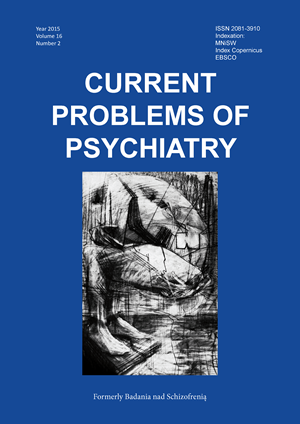The concept of movement in the Hermann Rorschach’s test.Reflections on Naamah Akavia’s book: Subjectivity in Motion. Life, Art, and Movement in the Work of Hermann Rorschach
Keywords:
kinaesthesia, engram, projectionAbstract
The inspiration for the present article was the book Subjectivity in Motion. Life, Art., and Movement in the Work of Hermann Rorschach by Naamah Akavia, a graduate from Cohn’ s Institute of History and Philosophy of Science and Ideas.
Akavia deals with Rorschach ideas, reaching to all the materials he had left, some of which have not been published before. Akavia separated his authentic opinions and intentions from the interpretations of other researchers and followers. She presented Rorschach against the background of his age and showed how it influenced him but also what was his own contribution. In her work, she also considered the achievements of the psychiatry of that time as well as the general atmosphere of academic and artistic world.
The present paper summarizes Akavia’s book although I have to admit that, due to the richness of problems raised, I leave some of them undiscussed to be followed more closely by those interested. My aim was to emphasize the originality of the ink blot experiment and its significance as a research tool into kinaesthesia. I have shown that the absence of such a tool might have caused insufficient elaboration of the topic of kinaesthesia in some personality development theories. I also point to the convergence between Rorschach idea of embodied perception and contemporary trends in philosophical (phenomenology) and psychological thought (ecological orientation in cognitive psychology, mental processes in social cognition).
All the remarks presented above are undoubtedly important. However, I would like to emphasize that the main reason why I chose Akavia’s book to analysis is something else. Namely, I believe that the most interesting question here is the comparison between the so called “movement reactions theory” represented by Rorschach, and the opinions of his most renowed followers, i.e. Zygmunt Piotrowski and John Exner. I would like to claim that Akavia’s book inspires the need to reconsider some way of interpreting “movement reactions”. I also wanted to highlight the significance of considering Rorschachs test as a cultural phenomenon.
References
1. Akavia N. Subjectivity in Motion. Life, Art, and Movement in the Work of Hermann Rorschach. New York, London: Routledge. Tay-lor & Francis Group; 2013.
2. Brüne M., Juckel G. poznanie społeczne w schizofrenii. Metaanali-za i poziom funkcjonowania psychospołecznego. Psychiatria po dyplomie, 2010; 7(6): 27-31.
3. ExnerJE. The Rorschach. A Comprehensive System. Hoboken, New Jersey: John Wiley & Sons; 2003.
4. Exner JE. A Comprehensive System. Interpretation. New York, Chich-ester, Brisbane, Toronto, Singapore: John Wiley & Sons; 1991.
5. ExnerJE. Searching for Projection in the Rorschach. Journal of personality assessment, 1989; 53 (3): 520-536.
6. Falkowski A. Ekologiczna orientacja w psychologii poznawczej – zagad-nienia percepcji. W: Wykłady z psychologii w KUL w roku akademickim 1985/1986, Lublin; Redakcja Wydawnictw KUL: 1988, s. 69-113.
7. Galison P. Image of Self. W: Dason L. red., Things that Talk: Object Lessons from Art and Science. wyd.2., New York; Zone Books: 2008, s. 257-294.
8. Hunca-Bednarska A. Nieco inaczej o teście plam atramentowych Hermanna Rorschacha. Eseje. Lublin: Wydawnictwo KUL; 2013.
9. Hunca-Bednarska A. Próba jakościowej analizy wypowiedzi dotyczących ludzi spostrzeganych na trzeciej tablicy testu H. Ror-schacha. Bad. nad schizofrenią, 2006; 7 (7): 242-258.
10. Hunca-Bednarska A. Refleksje nad J. Mazurkiewicza koncepcją popędów wtórnych i determinantami wypowiedzi w teście Her-manna Rorschacha. Bad. nad schizofrenią, 2006, 7 (7): 32-37.
11. Malmgren H. Rorschach ‘s. Idea of a ‘Movement” Response in the Light of Recent Philosophy and Psychology of Perception. Rorschachiana, 2000, 24 (1): 1-27.
12. Piotrowski Z. Perceptanalisis. Philadelphia: Ex Libris; 1979.
13. Smith BL. Object Relation Theory and the Integration of Empirical and Psychoanalytic Approches to Rorschach Interpretation. Rorschachiana, 1994,19 (1): 61-77.
14. Szafraniec J. Metoda Rorschacha w psychodiagnozie schizofrenii. Warszawa: Wydawnictwa Akcydensowe; 1985.
15. Stasiakiewicz M. Test Rorschacha. Warszawa: Wyd. Naukowe Scholar; 2004.
16. Stasiakiewicz M. podmiotowe i sytuacyjne wyznaczniki badania testem Rorschacha. Poznań: Wyd. Naukowe UAM; 1994.


